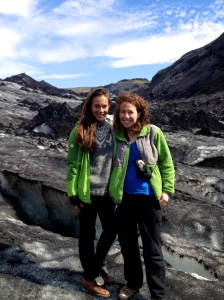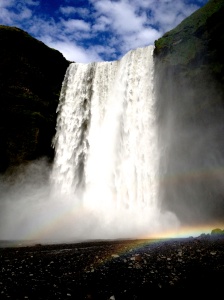Góðan daginn! My name is Emily McInerney and I am an OEP intern majoring in Natural Resources. I will be entering my junior year of college this fall semester. I recently spent seven weeks of my summer studying abroad in Iceland. When I first told friends and family of my plans I was met by confusion and concern. Mostly I received the astonished, “You really want to spend your SUMMER in ICEland?” or “Isn’t that where the sun never goes down? How will you sleep?” Well, I decided it was worth forgoing a tan because, as an environmentalist who aspires to an environmental career, Iceland is the perfect place to advance my education. Its geographic location and topography allow for the utilization of geothermal and hydroelectric energy and set Iceland at the forefront of renewable energy with the potential to lead the world toward a more sustainable energy budget.

Gullfoss Waterfall, one of the attractions of the Golden Ring

Multicolored rhyolite mountains of the Highlands
Iceland is located on the Mid-Atlantic Ridge where it lies on the rift between the North American and Eurasian tectonic plates and is considered a geologic rarity with glaciers and volcanoes creating a uniquely contrasting landscape. Beginning in 1999, the Icelandic government took initiative and began creating a clean energy Master Plan that described a list of prospective hydropower and geothermal project alternatives and ranked them based on their environmental, economic, and social implications.
I spent much of the trip further researching the highly controversial Kárahnjúkar hydropower plant (constructed prior to the implementation of the Master Plan) in northeastern Iceland. Hydropower constitutes more than 70% of Iceland’s electricity. In 2010, only 42% of hydropower available for generation had been utilized. There is therefore still opportunity for the expansion of hydroelectric energy. Hydropower is constantly replenished by the hydrological cycle and produces electricity through the process of harnessing running water. Its efficiency can be as high as 80% but it does not come without consequences. So while hydropower is, of course, better for the environment than coal, oil, and natural gas, especially since it is not a source of greenhouse gas emissions, it still has negative environmental impacts.
Hydropower requires the construction of dams and reservoirs, which can greatly transform the natural hydrologic patterns and disturb the geologic features and cycles of an area. Damming a river alters the flow of water, leading to sediment buildup upstream and thus erosion downstream, which therefore causes changes to the river channel and watershed area morphology. The altered water flow also results in a change of downstream water quality. This includes nutrient composition, temperature, and turbidity of the water and will thus affect which species the waterway is habitable to. For dams located near areas of high seismic activity, which is very common in Iceland, special consideration needs to be given to the design, because any tectonic activity could greatly damage the dam and cause significant changes to the movement of water in the area.

Mountains covered in moss and lichen

Hiking in Landmannalaugar
The Kárahnjúkar hydroelectric project raised public concern because of the environmental impacts listed above and because it provided electricity to the American greenhouse-gas-emitting aluminum smelter company, Alcoa (counter intuitive, right?). Many Icelanders were uncomfortable with the development of the power plant because it is also located within the bounds of the Kringilsárrani nature reserve, recognized for its geologic formations and thus identified as a protected area. The National Planning Agency initially rejected the plan for the project, citing that the Environmental Impact Assessment did not provide sufficient information, but the Minister for the Environment approved it four months later.
I contacted Herdís Helga Schopka (the Environment and Natural Resources Ministry’s expert who worked on the development of Iceland’s Master Plan) and inquired how, given her experience in the process of ranking the energy alternatives, she suspected Kárahnjúkar would have compared to the geothermal and hydroelectric projects evaluated in the Master Plan. She explained that the purpose of the Master Plan is to try and eliminate biases by putting it through a ranked process and that it is difficult to make an impartial decision when there is no price tag put on nature. Kárahnjúkar was essentially built because energy development coupled with the construction of aluminum factories is perceived to have many economic benefits. Therefore, there is less motivation to save the land- without monetizing the environmental costs they cannot outweigh the economic gains. She reasoned that while the power plant may have been built based onits Environmental Impact Assessment (EIA), it would not have been constructed if it had been analyzed and ranked in the Master Plan.

Eyjafjallajökull glacier covered in ash from volcanic eruptions

Iceland’s beautiful Skogafoss waterfall
I then followed up with Brynhildur Davidsdottir (a Program for Environment and Natural Resources Studies professor at the University of Iceland) for a second opinion. She concluded that there must be a balance between the three dimensions (environment, economy, and society) to achieve sustainability. Weak sustainability must have positive movement overall but it allows for tradeoffs. Strong sustainability has positive movement for all three dimensions. For Kárahnjúkar, it was easy to rationalize the economic value of the power plant as outweighing the environmental degradation because there was no ranking system applied to the EIA. Therein lies the tradeoff and thus it characterizes weak sustainability. The Master Plan, however, uses multi-criteria analysis and gives all three dimensions numerical value and thus portrays strong sustainability by creating a platform for comparison.
This concept can be applied to UConn’s Climate Action Plan (CAP). In 2008, UConn’s president signed the American College and University Presidents Climate Commitment (ACUPCC). This committed the university to carbon neutrality by 2050. Unfortunately, UConn doesn’t have the same access to renewable resources that Iceland does. Instead, the University created the CAP to organize mitigation and adaptation strategies for climate change and to help advance sustainability on campus. The CAP’s mitigation strategies are organized into three groups: energy, sustainable development, and transportation. Each group lists tactics for improvement and describes their estimated emissions reduction, first cost, rate of investment, and time of implementation. These tactics are then ranked as either limiting, good, or excellent.
Although not a numerical ranking as seen in the Master Plan, the CAP utilizes a similar technique to compare the environmental benefits in terms of carbon dioxide reduction to the cost of the project or program. The social aspect is not directly applicable to the CAP and was not included. The CAP can thus be said to characterize strong sustainability. UConn recently received the number one ranking for the Sierra Club’s 2013 Cool Schools Survey and this can largely be attributed to how UConn has strategized and implemented measures for achieving carbon neutrality and its technique for assessing the feasibility of its greenhouse gas reduction measures.
What I found supremely interesting about Iceland is that, despite having the capacity to run the entire country on renewable energy, it has a horribly large carbon footprint. This is because the general public does not understand what it means to be sustainable. They have plenty of warm water so they take long showers. They drive everywhere, even down the block for a quick coffee, because, to put it simply, they can – it’s socially acceptable.
Here at UConn, we are working to educate students, staff, and faculty on the importance of being environmentally friendly. This is done through the many events we hold throughout the year: EcoMadness, Earth Day Spring Fling, CIMA, and much more. This new number one ranking should give students pride in their school and will hopefully help us continue to decrease our carbon footprint.








